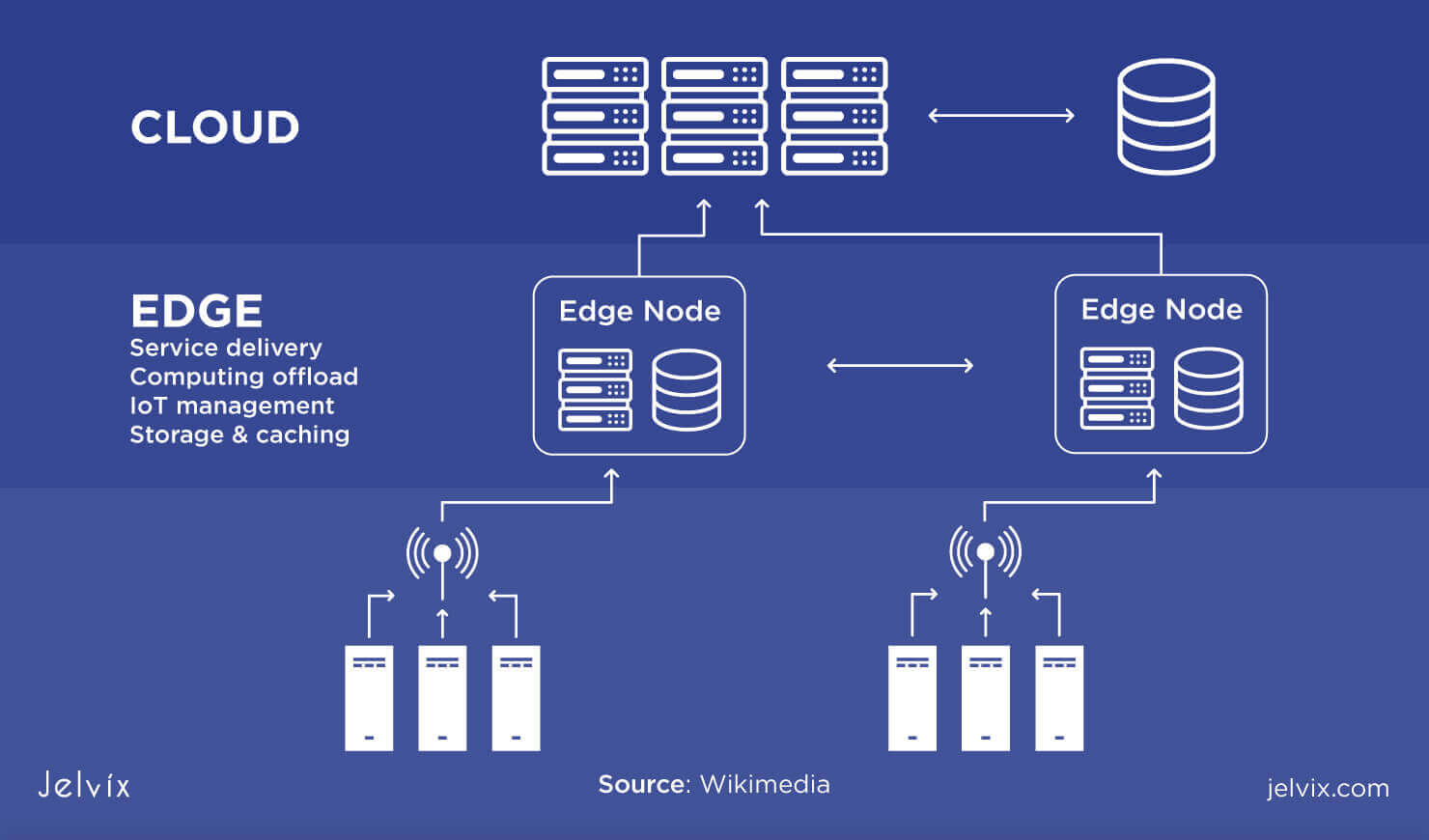Technology
Trends
Trends
By Nikita Dunggal
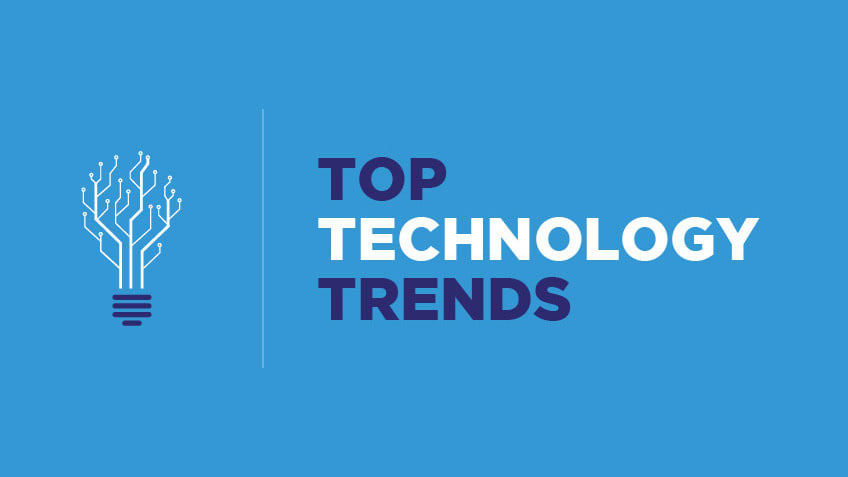
Table of Contents
- Artificial Intelligence (AI) and Machine Learning
- Robotic Process Automation (RPA)
- Edge Computing
- Quantum Computing
- Virtual Reality and Augmented Reality
- Big Data
- Gene Editing
- Precision Medicine
- Gene Sequencing
- Biomanufacturing
- Learning
Technology today is evolving at such a rapid pace, enabling faster change and progress, causing an acceleration of the rate of change, until eventually, it will become exponential. However, it is not only technology trends and top technologies that are evolving, a lot more has changed this year due to the outbreak of COVID-19 making IT professionals realize that their role will not stay the same in the contactless world tomorrow. And an IT professional in 2020-21 will constantly be learning, unlearning, and relearning (out of necessity if not desire).
What does this mean for you? It means staying current with new technology trends. And it means keeping your eyes on the future to know which skills you’ll need to know to secure a safe job tomorrow and even learn how to get there. All bows to the worldwide pandemic, most of the global IT population is sitting back, working from home. And if you wish to make the most of your time at home, here are the top 9 new technology trends you should watch for and make an attempt at in 2021, and possibly secure one of the jobs that will be created by these new technology trends.
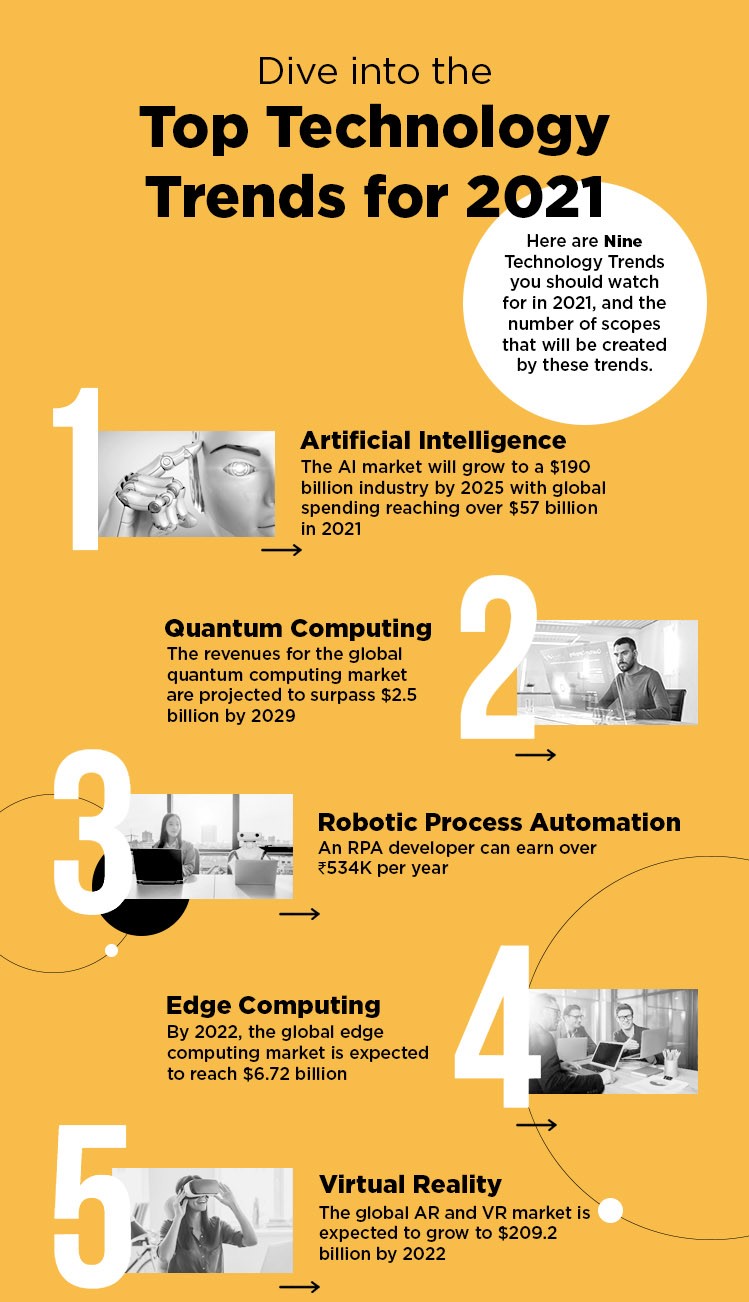
1. Artificial Intelligence (AI) and Machine Learning
Artificial Intelligence, or AI, has already received a lot of buzz in the past decade, but it continues to be one of the new technology trends because its notable effects on how we live, work and play are only in the early stages. AI is already known for its superiority in image and speech recognition, navigation apps, smartphone personal assistants, ride-sharing apps and so much more.
Other than that AI will be used further to analyze interactions to determine underlying connections and insights, to help predict demand for services like hospitals enabling authorities to make better decisions about resource utilization, and to detect the changing patterns of customer behaviour by analyzing data in near real-time, driving revenues and enhancing personalized experiences.
The AI market will grow to a $190 billion industry by 2025 with global spending on cognitive and AI systems reaching over $57 billion in 2021. With AI spreading its wings across sectors, new jobs will be created in development, programming, testing, support and maintenance, to name a few. On the other hand AI also offers some of the highest salaries today ranging from over $1,25,000 per year (machine learning engineer) to $145,000 per year (AI architect) - making it the top new technology trend you must watch out for!
Machine Learning the subset of AI, is also being deployed in all kinds of industries, creating a huge demand for skilled professionals. Forrester predicts AI, machine learning, and automation will create 9 percent of new U.S. jobs by 2025, jobs including robot monitoring professionals, data scientists, automation specialists, and content curators, making it another new technology trend you must keep in mind too! However, AI is the new trending technology since 2020 and survey says it will have a great scope in the future!
Mastering AI and Machine learning will help you secure jobs like:
- AI Research Scientist
- AI Engineer
- Machine Learning Engineer
- AI Architect
2. Robotic Process Automation (RPA)
Like AI and Machine Learning, Robotic Process Automation, or RPA, is another technology that is automating jobs. RPA is the use of software to automate business processes such as interpreting applications, processing transactions, dealing with data, and even replying to emails. RPA automates repetitive tasks that people used to do.
Although Forrester Research estimates RPA automation will threaten the livelihood of 230 million or more knowledge workers or approximately 9 percent of the global workforce, RPA is also creating new jobs while altering existing jobs. McKinsey finds that less than 5 percent of occupations can be totally automated, but about 60 percent can be partially automated.
Mastering RPA will help you secure high paying jobs like:
- RPA Developer
- RPA Analyst
- RPA Architect
3. Edge Computing
Formerly a new technology trend to watch, cloud computing has become mainstream, with major players AWS (Amazon Web Services), Microsoft Azure and Google Cloud Platform dominating the market. The adoption of cloud computing is still growing, as more and more businesses migrate to a cloud solution. But it’s no longer the emerging technology trend. Edge is.
Edge computing will increase as use of the Internet of Things (IoT) devices increases. By 2022, the global edge computing market is expected to reach $6.72 billion. And this new technology trend is only meant to grow and nothing less, creating various jobs, primarily for software engineers.
Keeping in line with cloud computing (including new-age edge and quantum computing) will help you grab amazing jobs like:
- Cloud Reliability Engineer
- Cloud Infrastructure Engineer
- Cloud Architect and Security Architect
- DevOps Cloud Engineer
4. Quantum Computing
Next remarkable technology trend is quantum computing, which is a form of computing that takes advantage of quantum phenomena like superposition and quantum entanglement. This amazing technology trend is also involved in preventing the spread of the coronavirus, and to develop potential vaccines, thanks to its ability to easily query, monitor, analyze and act on data, regardless of the source. Another field where quantum computing is finding applications in banking and finance, to manage credit risk, for high-frequency trading and fraud detection.
Quantum computers are now a multitude times faster than regular computers and huge brands like Splunk, Honeywell, Microsoft, AWS, Google and many others are now involved in making innovations in the field of Quantum Computing. The revenues for the global quantum computing market are projected to surpass $2.5 billion by 2029. And to make a mark in this new trending technology, you need to have experience with quantum mechanics, linear algebra, probability, information theory, and machine learning.
5. Virtual Reality and Augmented Reality
The next exceptional technology trend - Virtual Reality (VR) and Augmented Reality (AR), and Extended Reality (ER). VR immerses the user in an environment while AR enhances their environment. Although this technology trend has primarily been used for gaming thus far, it has also been used for training, as with VirtualShip, a simulation software used to train U.S. Navy, Army and Coast Guard ship captains.
In 2021, we can expect these forms of technologies being further integrated into our lives. Usually working in tandem with some of the other new technologies we’ve mentioned in this list, AR and VR have enormous potential in training, entertainment, education, marketing, and even rehabilitation after an injury. Either could be used to train doctors to do surgery, offer museum-goers a deeper experience, enhance theme parks, or even enhance marketing, as with this Pepsi Max bus shelter.
Fun fact: 14 million AR and VR devices were sold in 2019. The global AR and VR market is expected to grow to $209.2 billion by 2022, only creating more opportunities in the trending technology, and welcoming more professionals ready for this game-changing field.
While some employers might look for optics as a skill-set, note that getting started in VR doesn’t require a lot of specialized knowledge - basic programming skills and a forward-thinking mindset can land a job; another reason why this new technology trend should make up to your list of lookouts!
For MORE Technology related images, click the Gallery below.
BioHealth
1. Big Data

There is an unprecedented amount of data available in BioTechnology today, from the ever-growing omics technologies and integration of sensors and the Internet of Things (IoT) devices. Big data & analytics solutions allow BioTech startups to tap into this wealth of data to drive innovation. It allows biopharma companies to recruit patients for clinical trials more effectively. Startups and companies deploy bioinformatics solutions to develop better feed, improve crop and livestock varieties, and explore undiscovered microbes.
BioXplor discovers Safe Treatment Regimens
German startup BioXplor leverages big data to discover better and safer treatment regimens. It performs network pharmacology analysis to develop treatments from unstructured and disparate data sources. The startup’s solution determines the synergistic or antagonistic effects of drug combinations. It also analyzes patient data for responder and non-responder signals, improving patient outcomes and treatment response analysis.
BioBox Analytics develops Genomic Data Analytics Platform
Canadian startup BioBox Analytics develops a genomic data analytics platform. It uses a data library to manage all models, samples, and data and runs bioinformatic pipelines in the cloud. The solution identifies gene enrichment, tissues/cell expression, and ontology. The startup also provides solutions to visualize insights and query papers, datasets, and genes.
2. Gene Editing

Genetic engineering has come a long way from genetically modifying organisms by random insertion of foreign DNA to making precise edits in genomes. The increased efficiency of gene editing is due to the development of engineered nucleases, and lately CRISPR, as molecular scissors. This opens up applications in gene therapy for the treatment of genetic disorders as well as other conditions, with gene editing techniques adding, replacing, or silencing particular genes. The targeted gene modification also enables the development of better transgenic plants and animals.
PLANTeDIT provides Genome Editing Solutions
PLANTeDIT is an Irish startup producing non-transgenic, genome-edited plant products. The startup uses patented genome editing tools and its in-house transformation technology to enable efficient direct delivery and swift regeneration of genome-edited plants. PLANTeDIT mutates the FAD2 gene in soya to create a high oleic variant. The high oleic oils help food companies lengthen the shelf-life of food items.
Plastomics offers Chloroplast Editing
US-based startup Plastomics develops a next-generation delivery technology. The startup undertakes breeding with chloroplast engineered traits. Unlike nuclear traits, this leads to more effective trait integration, as well as speeds up time to market. This makes the startup’s solution suitable for applications such as modifying photosynthetic pathways and metabolic pathway engineering.
3. Precision Medicine

The falling costs of gene editing and gene sequencing make them more routinely applied in clinical practice. It enables precision medicine, an approach that allows physicians to determine which treatment and prevention strategies will work for a particular group. Moreover, it enables personalized treatment for the treatment of several diseases, including cancers. Biotech startups are leveraging precision medicine to identify new drug targets, discover novel drugs, offer gene therapies, and develop new drug delivery technologies.
iLoF offers Personalized Therapies
British startup iLoF offers a precise, patient-centric drug development platform. The blood-based platform finds biological nanostructures in liquid dispersions such as plasma. The platform is rapid and non-invasive and facilitates the development of precise and personalized therapies. The startup’s screening test classifies patients for clinical trials.
Dyno Therapeutics develops Gene Therapy
Dyno Therapeutics is a US-based startup developing AI-powered gene therapies. The startup’s CapsidMap platform optimizes adeno-associated viral (AAV) vectors to improve targeting ability. The solution maps the synthetic AAV capsid sequence space to develop better gene therapy vectors.
4. Gene Sequencing

The costs of DNA sequencing have fallen by 5 orders of magnitude since the early 2000s, opening up a wide range of applications in the industry. The reduced cost of sequencing whole genomes allows the identification of pediatric disorders, personalized treatments, and setting up large cohorts with extensive phenotyping. Sequencing also presents a rapid and inexpensive method to detect the presence of microbes, ranging from detection of pathogens in clinical and dairy samples to beneficial soil microbes. Biotech startups are innovating with new sequencing technologies, as well as novel applications for gene sequencing.
BioClavis offers Personalized Diagnostics
British startup BioClavis offers personalized diagnostics. The startup’s TempO-Seq platform enables quick and inexpensive high-throughput profiling of the protein-coding transcriptome. By using defined input sequences, the solution increases the efficiency and needs only 10 % sequencing reads as compared to RNA-Seq. The startup also develops a solution for the rapid and accurate identification of active COVID-19 infections.
BioSkryb provides Whole Genome Sequencing (WGS) Workflow
Bioskryb is a US-based startup developing ResolveDNA, a whole-genome sequencing workflow. The startup’s workflow is compatible with single cells, multiple cells, and low-input DNA samples. BioSkryb also offers the BaseJumper Bioinformatics Platform, compatible with most sequencing platforms, for DNA sequencing analysis.
5. Biomanufacturing
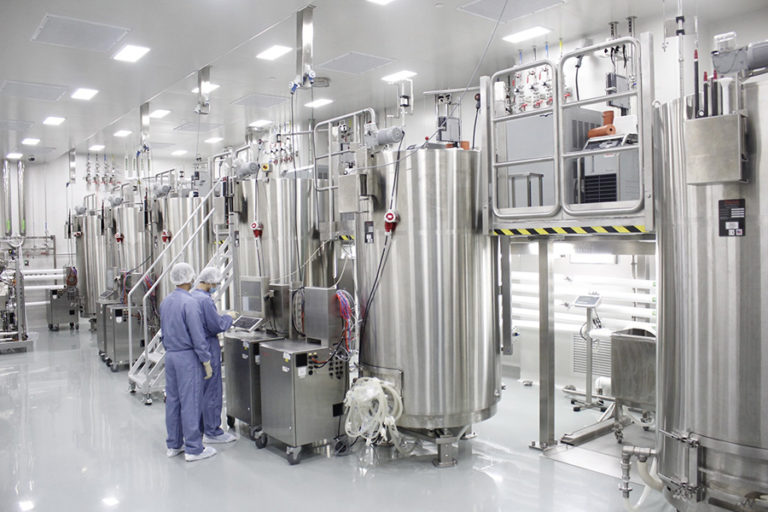
Biomanufacturing utilizes biological systems for the production of medical products and therapies, biomaterials, food & beverages, and specialty chemicals. Startups are advancing different cell culture, fermentation, and recombinant production technologies to make biomanufacturing inexpensive and scalable. The use of biological raw materials also makes it comparatively more sustainable as compared to other manufacturing paradigms. The industry’s production models are also adopting machine learning and automation. By integrating Industry 4.0 models, BioTech startups offer bioprocessing 4.0 to optimize each step of the production process.
Proteinea develops an Insect-based Production Platform
US-based startup Proteinea develops an insect-based production platform for next-gen biomanufacturing. The startup InsectaPro technology leverages mass-produced insect larvae as mini-bioreactors for recombinant production. It grows them in data-driven vertical farms, making the process predictable and environmentally sustainable. The solution enables a more scalable and robust alternative to conventional bioreactors.
Deep Branch offers Gas Fermentation
Deep Branch is a British startup that converts carbon dioxide from industrial emissions into high-value chemicals. It uses a proprietary gas fermentation process to turn captured carbon dioxide into Proton, a single-cell protein. Proton is optimized for use as animal feed and has high protein and vitamin content and an optimal amino acid profile
Learning

1. Hybrid Is the New Normal

Several industries thrived in this grand experiment in which employees shifted from offices to their homes. However, the preference is really for flexibility, and even in the midst of quarantines and isolation, many companies haven’t fully adopted a work-from-home model. There are essential employees who must be on site and executives who still travel. Some companies have been creative in allowing their workforce to gather in person by setting up outdoor offices.
2. Enhanced Immersive Technology
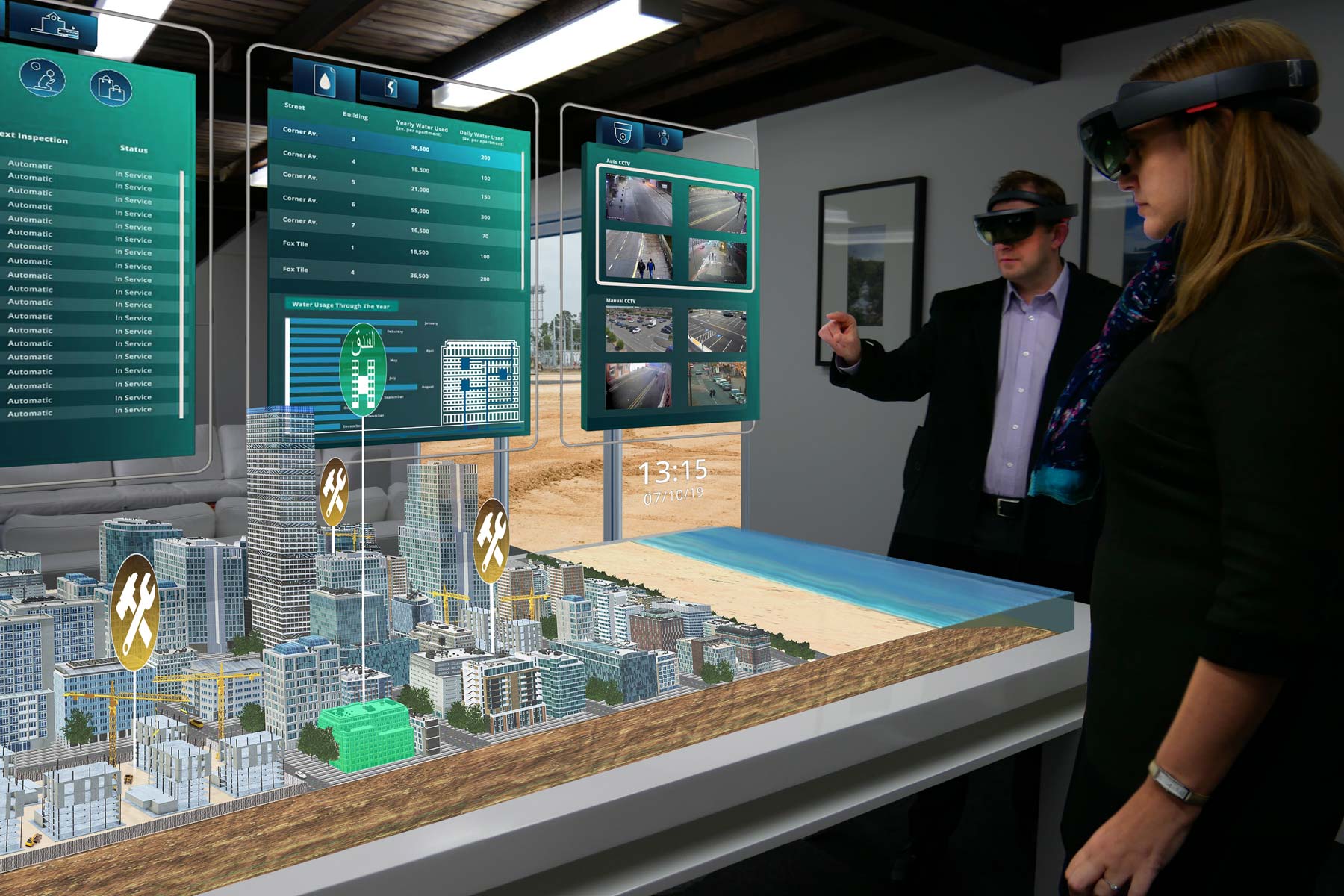
With the advent of 5G technology, more areas across the nation can support remote work and experiential platforms, such as augmented reality (AR) and virtual reality (VR). Implications for learning include more immediate and immersive experiences; an improved ability to meet employees where they are; and the ability to go deeper with content, environment and virtual “shoulder-to-shoulder” instruction. Zoom fatigue is showing us that video calls are not sufficient, especially when it comes to creating a virtual classroom, and is one reason organizations will increasingly rely on AR and VR.
3. Increased Workloads

In 2021, developing an enterprise-wide digital acumen will prove to be the antidote to some of the continued disruption, such as the increase in workload, broadening of job responsibilities and new skill requirements. Often, disruption isn’t about competition; rather, it comes from within. The same transformation that is creating growth for companies can also provide growth for employees by offering career development, wellness and other benefits to help with the increase in work. Evolving learning programs, in step with broader corporate evolution, can inspire employees, resulting in retention and growth.
4. L&D Is Leading the Charge

Learning organizations must adapt along with their workforce to the quickly evolving world, shifting to new areas of demand. Beyond the pandemic, there will be a substantial need for L&D to bring new workers up to speed rapidly and to diversify the skills of existing employees.
5. Adapting to Digital Formats

Organizations that were already on the path to digital transformation had a head start last year, but learning departments have the opportunity to take the lead. Tapping into digital platforms is half the battle, and the other is knowing how to learn — not necessarily a given for companies and teams focused on digital transformation without an embedded learning component.
As innovators know, being agile — experimenting as a way of working — is only successful if learning is built into the process. Moving fast just to move fast doesn’t create value if insights aren’t carried over from one iteration to the next. Therefore, learning isn’t just a department; it is a state of mind and a requirement for continued innovation and success.
Long-term trends and the nature of the current historical moment point to one conclusion: L&D will be critically important to companies navigating the post-COVID world, where success will hinge largely on the ability to adapt rapidly to unpredictable forces. No one will be able to tell L&D leaders in advance which new programs their companies might need; however, the need will be great, and timelines will be short.
 and Machine Learning.jpg)
.jpg)
